.
Cenotaph at Ruddell, Saskatchewan
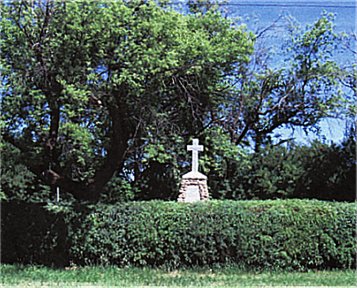
Forgotten Heroes
By Keith Picard
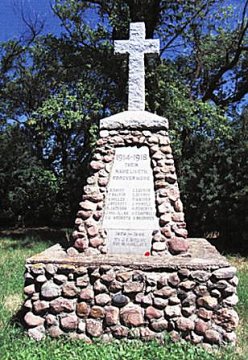 As
I was driving north on 16 highway I pulled into the small town of Ruddell,
Saskatchewan. This almost ghost town with its grain elevators missing and
having just a few residents still living here. It seemed to have nothing
here at all. As I pulled up to the post office I looked across the dirt
road and noticed a cenotaph behind a well-kept hedge. I took a picture
of it from the Ruddell post office first. Then I proceeded to go behind
the hedge to get a better look at it. I took the time to read the inscription
and the dates. 1914-1918, 1939-1945. I was amazed to see the number of
young men that were named from such a small town on this plaque. As I touched
these names from WWI knowing that they would not be returning to Canada
I wondered, did these boys all sign up together? Did they all die in the
same battle? What battle did they die at? Was it the Battle of Ypres, the
Somme, Vimy, Hill 70, Passchedaele, Cambral or the last 100 days? As I
touched the two names from WWII I wondered where they died, at sea, in
a bomber, The Dieppe Raid, Italy, Sicily, Juno Beach or maybe in The Battle
of The Scheldt, at Falaise or clearing the Channel ports.
As
I was driving north on 16 highway I pulled into the small town of Ruddell,
Saskatchewan. This almost ghost town with its grain elevators missing and
having just a few residents still living here. It seemed to have nothing
here at all. As I pulled up to the post office I looked across the dirt
road and noticed a cenotaph behind a well-kept hedge. I took a picture
of it from the Ruddell post office first. Then I proceeded to go behind
the hedge to get a better look at it. I took the time to read the inscription
and the dates. 1914-1918, 1939-1945. I was amazed to see the number of
young men that were named from such a small town on this plaque. As I touched
these names from WWI knowing that they would not be returning to Canada
I wondered, did these boys all sign up together? Did they all die in the
same battle? What battle did they die at? Was it the Battle of Ypres, the
Somme, Vimy, Hill 70, Passchedaele, Cambral or the last 100 days? As I
touched the two names from WWII I wondered where they died, at sea, in
a bomber, The Dieppe Raid, Italy, Sicily, Juno Beach or maybe in The Battle
of The Scheldt, at Falaise or clearing the Channel ports.
These brave boys from Saskatchewan, Canada all volunteered
to go fight an enemy that had started a war that terrorized their neighbours
as well as the world. They now lie in graves over there, marked or unmarked,
never to return to Canada. Yet this is just one town here in Saskatchewan.
There are many more throughout Saskatchewan and the rest of Canada just
like this one.
As I stood there I wondered when the last time a bugler
played The Last Post or a piper played the Flowers of The Forest here?
When was the last time the act of remembrance had been said over them?
This small dying Saskatchewan town paid a high price for this nation in
two world wars as well as the rest of Canada. “They gave up all of their
tomorrows for all of our todays” This monument says it all. “Lest We Forget”
“At The Going Down Of The Sun And In The Morning We Will Remember Them.”
1914 – 1918 Their Name Liveth For Evermore
S. Davy; F. Salter; A. Miller; J. Beckett; S. Jackson;
J. McMillan; V.C. Amboys;
C. Locker; C. Beachy; M.Mather; C. Pringle; H. Roberts;
H. Campbell; S. Bremner.
1939 – 1945
F/O J.E. Wright; Sgt. W.H.Gillatt
Keith Picard
P.O. Box 649 Dalmeny, Saskatchewan, CANADA S0K
1E0
kpicard@sasktel.net
1-306-254-4470
Editor: if you wish to see more Saskatchewan Cenotaph
photos click on Keith Picard’s site http://cap.estevan.sk.ca/ssr/skcenotaphs/
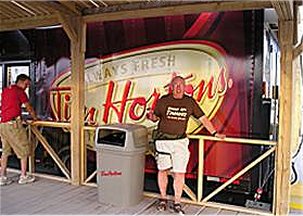 Ted
Hackett who contributes greatly to our Short Bursts Page, has a son,
Robert, serving in Afghanistan. This is a picture of Robert in the
compound, sampling the fare at Tim Hortons.
Ted
Hackett who contributes greatly to our Short Bursts Page, has a son,
Robert, serving in Afghanistan. This is a picture of Robert in the
compound, sampling the fare at Tim Hortons.
Robert writes to his Dad:
“I thought you all might find this of interest.. It is
probably the only Tim Hortons in the world where the customers are armed
and there is a sign telling you that, in case of an alarm, Tim Hortons
will re-open 15 minutes after the "all clear" sounds.
I guess a good coffee and a doughnut is a lot better than
a strong cuppa in a cracked mug and a hard biscuit served up by the old
gal in the NAAFI. Wagon”
As our chaps in Afghanistan read Short Bursts it is appropriate
that we relate this WWII “Naafi” experience.
THEY ALSO SERVE
While I was on a construction site, a snappy little van
came selling coffee, sandwiches, and refreshments. This brought to mind
an incident, which happened while serving with the Air Force.
Everything was blacked out and we sat under the planes
waiting for our turn to take off on one of the thousand bomber raids. The
night was silent, broken only by the put-put of a tiny Morris – Austin
van. This was owned by two old timers who, during the day, used it in their
property repair business and cleaned it out for the evening.
They were with the Salvation Army and as part of their
war effort, the C.O. allowed them to come onto the base to go from one
plane to another with whatever things rationing would allow. Mostly it
consisted of red-hot cocoa. At other times they would just stand to one
side with those boys who wanted a little consolation. One of their favourite
“treats” was what they called their “Lucky Bags”. These were broken biscuits,
which the lady members picked up at a local factory during the day. On
take off one would see the little van on the highway with the old timers
waving God-speed to us all.
When I see them on the street at Christmas with their
kettles, I always see those gentlemen so clearly. As ex-service men they
were too old to serve but found great pride helping the war effort by bringing
a little comfort to the boys.
One of the gentlemen, Mr. Pointon, was a fat tiny fellow
with his jolly face always smiling and bringing a smile from us. He would
have made a wonderful Santa Clause, so pleased as he gave out those bags
of biscuits.
Reprinted from CONTACT Oct. 1990.
ANSON ANECDOTES
CONTACT Volume 21 Issue 3
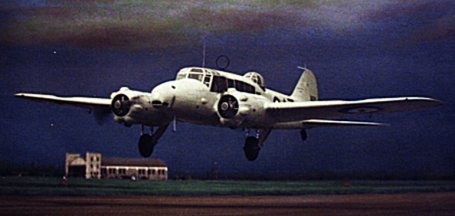
Avro Anson
Anson Shoots Down Me 110
An Anson reconnaissance aircraft of Coastal Command shot
down a Messerschmitt 110, which, with three others, was machine gunning
British trawlers off the South East coast.
Although his aircraft was only lightly armed and was 100
miles per hour slower than the fighters, the Anson pilot immediately attacked
while his wireless operator sent out a call for help.
One of the Messerschmitts turned away from the trawlers
and came at the Anson on the beam, firing all the time. The Anson gunner
in his turret amidships, fired back keeping the Messerschmitt in his sights
until it zoomed close overhead. Then, as he swung around to follow it,
he saw it burst into flames and dive vertically into the sea.
In the mean time the trawlers were putting up a stiff
barrage of anti-aircraft fire against the other Messerschmitts. Spitfires
appeared and attacked the remaining enemy aircraft just as the Anson scored
its victory.
Ted Hackett
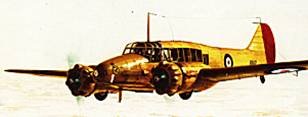 The
Avro Anson, often referred to as “Faithful Annie”, remained in service
from 1939 to 1967. There were 12,000 aircraft of different marks produced,
almost 7000 in Britain alone. The first Anson to enter service with the
Royal Air Force joined No 48 Squadron at Manston, Kent, on March 6, 1936.
The Anson was at first, the backbone of Coastal Command, and eventually,
with the Tiger Moth, Harvard, and Bolingbroke, the mainstay of the British
Commonwealth Air Training Plan (BCATP). Thousands of aircrew, Pilots, Navigators,
Bomb Aimers, and Wireless Operators, received their training on this aircraft
during the second world war.
The
Avro Anson, often referred to as “Faithful Annie”, remained in service
from 1939 to 1967. There were 12,000 aircraft of different marks produced,
almost 7000 in Britain alone. The first Anson to enter service with the
Royal Air Force joined No 48 Squadron at Manston, Kent, on March 6, 1936.
The Anson was at first, the backbone of Coastal Command, and eventually,
with the Tiger Moth, Harvard, and Bolingbroke, the mainstay of the British
Commonwealth Air Training Plan (BCATP). Thousands of aircrew, Pilots, Navigators,
Bomb Aimers, and Wireless Operators, received their training on this aircraft
during the second world war.
The original aircraft, Avro type 652, was a six passenger
commercial aircraft designed by Roy Chadwick, the designer of the Lancaster.
Two of the aircraft, G-ACRM and G-ACRN, flew on commercial routes with
Imperial Airways. In 1934 the Avro Company adopted the design to meet an
Air Ministry request for a coastal reconnaissance aircraft. The new aircraft
had a gun turret in the mid-upper position and a forward firing Vickers
machine gun on the port side forward of the cockpit. The prototype flew
in March 24, 1935 and the Air Ministry placed an order for 174 aircraft
in July 1935.
The Anson was the first twin engine aircraft in the RAF
to have retractable undercarriage. The under carriage was controlled by
a hand crank situated by the Pilot’s seat and required 144 turns of the
handle to complete the retraction. This task was usually carried out by
one of the other members of the crew, the Navigator or the Wireless Operator.
The Anson was considered obsolete at the beginning of
the war, however eleven Squadrons were still serving with Coastal Command.
They were employed in patrolling the Coastal areas of the North Sea watching
for enemy surface raiders besides doing convoy and anti-submarine patrols.
One of the first attacks on a U-Boat was carried out in September 5, 1939
by K6187 No. 206 Squadron, which dropped two 100 lb. Bombs. The Anson aircraft
engaged in a number of combats with Luftwaffe aircraft. No.500 Squadron
, based at Detling, fitted their aircraft with extra guns, one on each
side of the aircraft, and shot down several Bf 109 fighters during the
Dunkerque evacuation. The Anson of Coastal Command were eventually replaced
with the Beaufort, Hudson, and Blenheim, but they continued to operate
with Command Operational Training Units.
The Anson also played a small part with Bomber Command
during the early months of the war. The first Squadrons to receive the
Anson were No. 58, 61, 144, and 21. They stayed on strength for a few months
until replaced by the Whitley and the Wellington. The Anson remained in
service in Bomber Command in a variety of roles during the war.
The Anson was used as a Gunnery trainer. 313 of the aircraft
were fitted with the Bristol type 1, Mark IV turret, the same type used
on the Bolingbroke. They performed a variety of duties such as Air Sea
Rescue, Air Transport. The Anson was also used on occasion for dropping
off and picking up supplies and agents in occupied Europe.
One of the greatest uses of the Anson was the British
Commonwealth Air Training Plan in Canada and 1528 aircraft were delivered
from Britain. Others were eventually manufactured by Canadian firms. The
Anson was modified in Canada with cockpit heating, hydraulically operated
undercarriage, and interior panelling. In Canada the aircraft was used
at 50 RCAF stations; 19 Service Flying Schools, 10 Air Observer schools,
and 4 Operational Training units, eight Bombing and Gunnery Schools had
a small number on strength. #4 B&G School at Fingal had 8 Anson, while
No. 8 B&G in Lethbridge had 2.
There is an Anson on display at the Brandon Air Museum
in Manitoba, and the Alberta Aviation Museum in Edmonton, Alberta. The
Lancaster Museum in Nanton, Alberta, is in the process of restoring an
Anson as part of their Bomber Command exhibit.
The book AVRO ANSON by Alan W. Hall and Eric Taylor, published
by Almark Publications is a treasure chest of information.
We are indebted to Barb Fraser of the Alberta Aviation
Museum for photographs that accompany this article.
Editor: When we lived in Winnipeg in the '50s there
was a Bajoranson Air Services that purchased, through Crown Assets Disposal
Corporation, some Anson aircraft which were mothballed at the old MacDonald
Air Base. I spoke to the Company owner and asked how he transported the
aircraft from MacDonald to Winnipeg where the aircraft were being brought
up to Department of Transport flying standards. He said that they took
the planes out of the mothball state, started the engines, took off, flew
three circuits around the airdrome and, if the kite was still flying, they
crossed their fingers, and headed for the Winnipeg Airport.
Do any of our readers in the Winnipeg area, know what
happened to these Anson aircraft. To whom were they sold? They could be
traced through D.O.T. registration. It would be appreciated if someone
could look into this.
Interesting note: The lady in Crown Assets Disposal
Corporation, Ottawa,in the '50s, to whom all bids were directed, was Mrs.
Bidgood.
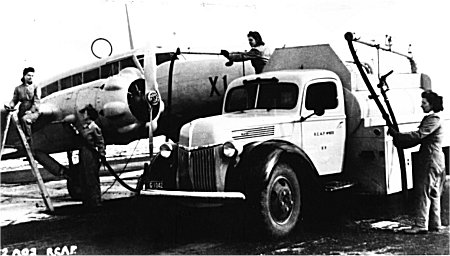
WAAFs refuelling an Anson at #2 AOS (Air Observer’s
School)
Can any Ex-WAAFs comment on this picture?
PUBLISH – RETRACT – PUBLISH AGAIN
In the September 2006 Page http://www.hillmanweb.com/rcaf/mag/0609.html
in support of a WW II story, we published a picture of the 423 Squadron
crest.
In the October 2006 Page http://www.hillmanweb.com/rcaf/mag/0610.html
we printed a letter received from a Member whose name I will not mention,
but his Initials are Ted Hackett.
“Nice September Issue, I sent it off to a couple of friends
and to my son in Khandahar, Afghanistan. My only complaint would be the
use of the modern day Squadron crest in a story about a wartime unit.
But then, I'm a nitpicker as everyone knows.”
The following has just been received from Don Macfie who
did his first tour on 423 Squadron and his second tour on 422 Squadron.
"This is the original crest. The one I wear. While
still at Oban late 1942 our Welsh Corporal armourer RAF, who had studied
at the Royal Academy of Art, drew up this example and presented it to the
W/C, who pushed it on up the line."
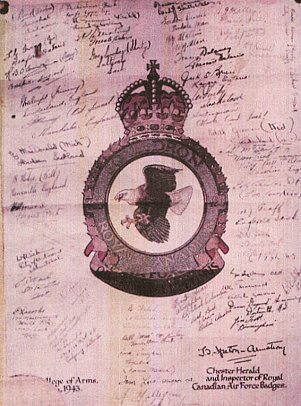
423 Squadron Crest received Royal Assent 1943.
Crest signed by Squadron crews.
Don Macfie continues.
One day this Armourer artist was out on the trots doing
his DIS. He was checking the very pistol behind the Second Pilots seat
and, with out bothering to take the pistol out of the pouch, he reached
in and pulled the trigger. It fired a three star flare. He caught each
star in his bare hands and threw them out the window. He wore bandages
for a long time and was awarded a M.I.D. He should have received either
the AFM or BEM.
When I was tour expired and just hanging around, he got
a chunk of burlap and painted a portrait of me. He then copied it onto
paper, gave it to me, and had the original hung in a gallery somewhere.
WW II was not all fighting eh!
At the end of this September I had the good fortune of
an afternoon visit with an old Air Gunner who, on January 3, 1941, was
in our draft of recruits from North Bay, Ont., bound for Manning Pool in
Toronto.
Since the war our paths have seldom crossed. And what
did we talk about? Nothing about his 30 trip tour on Stirlings RAF, nothing
about his second tour on Lancs RCAF, nothing about the 110 and 109 he shot
down, or the DFC he was awarded. But oh, the stories!
One gem he told me is surely good enough to pass along.
We were reminding each other of those winters in the UK, damp uniforms,
damp bed sheets, nothing to put in the little iron stove. One day he and
his mid-upper gunner who was shorter than he was, formed a plan to raid
the coal compound.
The piles of coal were well fenced and guarded at night
by a foot patrol with a flashlight.
They got into the coal pile undetected but, when they
got outside the fence with their illegal coal, down the footpath came the
patrol flashing his light around. Al grabbed his air gunner accomplice
and, flipping the greatcoat collar up around his friend’s head and face,
placed him in an amorous embrace with the coal between them. When the flashlight
was shined on them the Patrol chap said, “oops, sorry”. They were then
off to the hut with their coal.
This was Al Calquhoun from Sturgeon Falls. He short circuited
out of Wireless School in Montreal and was overseas ahead of me as a straight
Air Gunner. When I was crewing up at Debert, Nova Scotia, news filtered
back across the sea that Al had beaten up on six London Bobbies. This became
legend until I finally got the story straight. Al showed me the scar and
patch on top of his head where the hair does not grow as proof that it
took six London Bobbies to beat him up.
SEARCH PATTERN
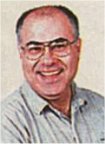 Will
Chabun, in one of his columns in the Regina Leader Post, write as follows.
Will
Chabun, in one of his columns in the Regina Leader Post, write as follows.
………..Got an interesting letter for help recently from
Bernice Priesnall of Camberley in Britain. She writes that in 1944 a Typhoon
fighter-bomber crashed near what is now the home of her grandfather in
Britain. Killed was Pilot, F/O Nicholas Stusiak of Bienfait, Sask.
Will Chabun
Bernice writes, “My Grandfather’s house is on the site of
crash in which Nick and others lost their lives. The reason I am trying
to find out more about Nick is that my grandfather was digging in the garden
and found an RCAF identity bracelet with Nick’s name on it and, on the
reverse, the inscription, ‘NICK FROM ELLEN’.
I would like very much to return this bracelet to his
family and I wonder if you could help me do this. .My mother is particularly
anxious to do this as she witnessed the plane go down when she was a young
girl and she has never forgotten this. We all feel that the bracelet should
go home to those who loved him. I feel an affinity with the airman as I
am cabin crew with British Airways and my grandfather was in the RAF at
the same time as Nick.
If anyone can help, contact Bernice at:
1 Fernhill Close,
Blackwater, Camberley,
Surry, GU17 9HD. England.
bernielgw@aol.com
or
Will Cabun
atlargewc@yahoo.ca
Good evening John.
I have a request from a Mr. P. Williams who is doing
a search for a lady. He wants to know about a P/O Charles Murray
a pilot with 83 Squadron. He was shot down by a night fighter on
a raid to Cologne on the night of June 16/17, 1943 in Lancaster MkIII ED907.
His rear gunner was F/O Jack Mckay, RCAF.
Where else would you suggest that he look?
Ted
tedgene@telusplanet.net
From: "David Reeve" d.reeve@tiscali.co.uk
To: cahsregina@hotmail.com
Subject: 425 Sqn. RCAF aircrew F/S E.A.Powell from Moose
Jaw
Date: Wed, 18 Oct 2006 23:55:02 +0100
I am seeking info about F/S Powell 425 Sqn RCAF whose
Halifax III LW390 KW-J crashed in N. France February 21/22 1944.
He survived and with 2 others and successfully evaded
capture and returned to England via Gibraltar.
While hiding in a safe house in Amiens, organized by the
legendary Balfe family of Hornoy, he gave a contact address to a fellow
successful evader,
Flt Lt Joe Oliver 613 Sqn. Mosquito pilot.
Joe's daughter Janet still has that scrap of paper
with 7 fellow evaders named plus a mass of other information about the
helpers in the Amiens region and Paris who also must have helped F/S Powell.
We would be most grateful if you could possibly
help track down F/S Powell or members of his family by pointing me in the
right direction. Perhaps the letters page of the Moose Jaw newspaper could
help - do you have an e-mail address for this paper. I failed to find one
on the internet.
The aim is to exchange information about the evasion exploits
of this group of allied aircrew.
I am now a member of the Evasion Lines Memorial Society
which carries the torch of the RAF Escaping Society which folded its wings
in 1995. www.escapelines.com
with best wishes, David Reeve
The address was as follows:
G.L. Powell 1054? 7th Ave. N.W. Moose Jaw, Sask.
BRANCH REPORTS
Northern Saskatchewan Group
We had our annual barbequed steak get together on September
18th. Our turn out was nineteen which included partners as well as
two widows of deceased members. As usual, the steaks were scrumptious,
thanks to the expertise of a willing volunteer chef, Earl Goodman.
Our October 16th meeting took place with 14 members
in attendance; numbers affected somewhat by the first freezing rain and
snow of the fall season. We had as guests, two area counselors from
Veterans Affairs Canada who gave us a presentation bringing us up-to-date
on benefits and how changes affect us. The presentation was well
received by the group.
The Christmas banquet will be held at 1:00 p.m.
December llth this year, a change from the previous years when it was an
evening function. Night vision was affecting attendance at our 7:00
p.m. hour.
Best wishes to all,
Harry Thompson
CORRESPONDENCE
Letter to Charley Yule.
Dave Sutherland has given me your email so that I might
ask you for information. I hope you can help.
Rear gunners suffered inordinate losses in the early years
of the war and a figure of six weeks has been bandied around as expected
life. But it is my understanding that by January 1945, Luftwaffe night
fighter activity was low. It should follow that rear gunner loses should
be low in January 1945. Is it possible to obtain any statistics?
Yours sincerely
Michael O'Hagan
Aircrew Association Vancouver Island Branch
We publish Aircrew Memories
victoriapublishing@shaw.ca
Mr. Moyles;
Good afternoon and hello......I am writing to ask for
your assistance concerning an Air Gunner who served in the RAF during World
War II. I have an old copy of "They Hosed Them Out", also published
as "Rear Gunner" by John Beede, RAAF. I have had this book for 20
years and pull it out every so often to read as I still find his story
fascinating... and of course I have a deep interest in Bomber Command history.
I still wonder what ever
became of Mr. Beede. Although he was an Australian
serving in Bomber Command and the TAF, I have been unable to locate any
information about him through my Australian sources. I have also
been unable to find an Australian Air Gunners website. My conclusion
is that John Beede is a pen
name.
Just the same is there any one out there that may know
who he really was and what happened to him after the war. His book
is one of the best I've read. Any assistance you can give me is greatly
appreciated.
Best Regards, and looking forward to your reply
Sincerely,
Dave Kirby
Banica, Dominican Republic davek92@hotmail.com
Hi John,
I was just surfing the net for Remembrance Day articles
for a slideshow I want to do for November 11 and came across airmuseum.ca
and thought I would pass on a link to a couple of slideshows I just
made. One is entitled, Keeping the Home Fires Burning ,dedicated
to the spouses of our Canadian Armed Forces and the other is entitled,
A
Single Maple Leaf dedicated to our Canadian Troops. You can view them
at the following link:
http://www.photodex.com/sharing/viewalbum.html?bm=33258
Cheers,
Gerry Malone
Hello John and Doreene
I found your excellent website quite by chance and was
struck by the contribution in February 2004 by Harry McLean - “The Night
of September 6 1943“
I am researching an ex-workmate, P/O Theo L. Simpson,
Lancaster Pilot with 100 Squadron who failed to return on 20 October 1943
and I see from his Log Book that he participated in that operation. The
article certainly reflects the hazards of the night and I was pleased to
read that further letters from the same A/G would appear later.
So far, I have failed to find any but, in the items for
March 2004, read one that contained a reference to navigator F/O P. Lankester
of Bexhill-on-sea. I live very near there and found an entry in our local
telephone directory for P. F. Lankester of Little Common which is on the
western outskirts of the town. So, hopefully, he is still alive and well.
Which brings me to my last point. F/Sgt Gerald M.M. Rozak,
RCAF, of Ottawa went through OTU and CU with Theo and was his MUG for 14
operations before being grounded. Is he by any chance one of your members?
I look forward to returning to your website's Archives
ASAP as I am sure they will provide hours of interesting reading and I
shall certainly hope to find more contributions by Harry McLean.
Kind regards,
Aubrey Sinden aubrey_sinden@tiscali.co.uk
RETURN FIRE
Ross Hamilton's "Chicken Story" reminds me of a
similar incident at 10 OTU, Abingdon in the Spring of 1942.
We were flying from a satellite station at Stanton Harcourt and the local
pub was The Checkers, by the ferry on the river. Two Sergeant Aircrew,
after a heavy night of drinking, spotted two ducks by the river, killed
them, and proceeded to pluck the feathers on their return to the Sergeants'
Mess. There they cleaned the carcasses and placed them in an oven and cooked
them for a very late night meal.
The next day the farmer followed the trail of feathers
to the mess, found the remains in the waste bin, and contacted the
Station Police and the Civil Police. The Sergeants were prosecuted and
appeared in the Magistrates Court in Oxford, where they were fined ten
shillings.
The Oxford Mail later carried the headline,
RAF Sergeants Kill Ducks.
"We did it in self defence," was their explanation to
the Magistrates.
Incidentally, it is nice to see the "Coal Powered Halifax
4" story is still running.
Fred Heathfield
Chester, UK
John,
Howard's note in the Sept issue about his first flight
got me wondering about how many of us AG/Wags got rides in ac before enlisting.
My first flight was in a Junkers 33, CF AQW, pilot Ron George, of Canadian
Airways Ltd from Ilford, on the Hudson Bay Railway to God's Lake Gold Mine.
That was in March of 1935 and I was 12 years old.
Our log house was next door to the Miller family, who
I got to know well, especially Pat. Pat was learning the code or
the “morice cord” as he sometime called it and got me started to learn
also.
My mentors were Mr. Hec McKenzie, Base Agent/Operator
for Canadian Airways and Mr. Jack Wye, Base Agent/ Operator for Wings Ltd.
Through them I also got to meet several of the pilots that flew in and
out of the mine site and on several occasions was taken up on short flights.
There was no runway just skis in winter, and floats in
summer.There never were any seats in the passenger cabin; passengers sat
on bags or boxes of freight. When we left Gods Lake in the summer of 1937,
we flew out to Lac Du Bonnet in a Fairchild 71 of Wings Ltd. CF AQW.
Later, this aircraft had an engine change from the inline, liquid cooled
German engine, to an air cooled radial and became a Junkers 34.
Glen Clearwater
gecchief2@shaw.ca
Ed. Thanks Glen. I was on squadron with Pat Miller
for two years. Pat ended up on a Catalina Squadron patrolling the Indian
Ocean. Those of you who have the Short Bursts Commemorative Issue 1983
– 1993, see Page 99. Pat Miller gives an account of “THE LOCUST PATROLS”
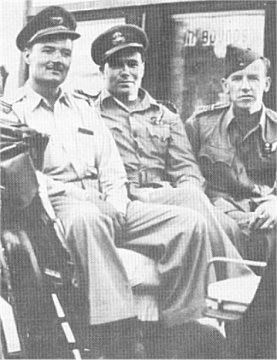
Mel Livingstone, Pat Miller, Daly
Dorgan
In Karachi India (now Pakistan)
Pat is no longer with us. We will remember him.
LAST POST ~ Charlie Yule,
Editor: yulec@mts.net
F. ALEX McQUARRIE, #0077, CALGARY,
AB: Alex passed away at the age of 85 on
September 25th/06. He enlisted in the RCAF as R102405 at Regina,
SK March 22/42 and was posted for Manning Depot at Penhold, AB where he
was selected for WAG training. He attended #3 Wireless School in
Winnipeg on Course #25 and upon completion was posted to #5 Bombing and
Gunnery at Dafoe, SK - Course #27, where he received his WAG Brevet and
Sergeants Stripes.
Overseas for OTU training on Hampden's at Cottesmore,
Alex as then posted to #424 Squadron, Topcliffe, 6 Group, where he and
his crew converted to Wellington's (Wimpy's). On Operations April
19th 1943, they were shot down on their 9th Op (Frankfort) and interned
as POWs until being liberated May 2nd/45 and returned to the UK May 4/45.
He was discharged with the rank of Flying Officer - J96427, on October
5th, 1945.
In addition to being a Life Member of the Ex Air Gunner's
Association of Canada, he was also a Life Member of the RCAF National POW
Association and the Aircrew Association of Southern Alberta.
Editor’s Report
The frost is on the pumpkin and it is time to batten
down the hatches for winter.
On the farm during the 20s and 30s my Dad piled straw
and manure around the house to keep out the cold winter winds. There was
always controversy regarding when it should be removed prior to the spring
thaw. But you urban types would not understand.
Consider the questions being asked in our Correspondence
section. You just might be able to throw light on someone’s question.
A big thank you to all those who contributed to this Page.
Keep well.
Cheers
John & Doreene Moyles
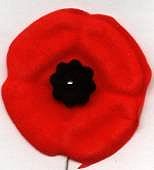
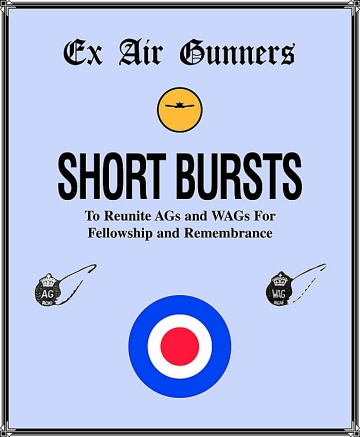

 As
I was driving north on 16 highway I pulled into the small town of Ruddell,
Saskatchewan. This almost ghost town with its grain elevators missing and
having just a few residents still living here. It seemed to have nothing
here at all. As I pulled up to the post office I looked across the dirt
road and noticed a cenotaph behind a well-kept hedge. I took a picture
of it from the Ruddell post office first. Then I proceeded to go behind
the hedge to get a better look at it. I took the time to read the inscription
and the dates. 1914-1918, 1939-1945. I was amazed to see the number of
young men that were named from such a small town on this plaque. As I touched
these names from WWI knowing that they would not be returning to Canada
I wondered, did these boys all sign up together? Did they all die in the
same battle? What battle did they die at? Was it the Battle of Ypres, the
Somme, Vimy, Hill 70, Passchedaele, Cambral or the last 100 days? As I
touched the two names from WWII I wondered where they died, at sea, in
a bomber, The Dieppe Raid, Italy, Sicily, Juno Beach or maybe in The Battle
of The Scheldt, at Falaise or clearing the Channel ports.
As
I was driving north on 16 highway I pulled into the small town of Ruddell,
Saskatchewan. This almost ghost town with its grain elevators missing and
having just a few residents still living here. It seemed to have nothing
here at all. As I pulled up to the post office I looked across the dirt
road and noticed a cenotaph behind a well-kept hedge. I took a picture
of it from the Ruddell post office first. Then I proceeded to go behind
the hedge to get a better look at it. I took the time to read the inscription
and the dates. 1914-1918, 1939-1945. I was amazed to see the number of
young men that were named from such a small town on this plaque. As I touched
these names from WWI knowing that they would not be returning to Canada
I wondered, did these boys all sign up together? Did they all die in the
same battle? What battle did they die at? Was it the Battle of Ypres, the
Somme, Vimy, Hill 70, Passchedaele, Cambral or the last 100 days? As I
touched the two names from WWII I wondered where they died, at sea, in
a bomber, The Dieppe Raid, Italy, Sicily, Juno Beach or maybe in The Battle
of The Scheldt, at Falaise or clearing the Channel ports.
 Ted
Hackett who contributes greatly to our Short Bursts Page, has a son,
Robert, serving in Afghanistan. This is a picture of Robert in the
compound, sampling the fare at Tim Hortons.
Ted
Hackett who contributes greatly to our Short Bursts Page, has a son,
Robert, serving in Afghanistan. This is a picture of Robert in the
compound, sampling the fare at Tim Hortons.

 The
Avro Anson, often referred to as “Faithful Annie”, remained in service
from 1939 to 1967. There were 12,000 aircraft of different marks produced,
almost 7000 in Britain alone. The first Anson to enter service with the
Royal Air Force joined No 48 Squadron at Manston, Kent, on March 6, 1936.
The Anson was at first, the backbone of Coastal Command, and eventually,
with the Tiger Moth, Harvard, and Bolingbroke, the mainstay of the British
Commonwealth Air Training Plan (BCATP). Thousands of aircrew, Pilots, Navigators,
Bomb Aimers, and Wireless Operators, received their training on this aircraft
during the second world war.
The
Avro Anson, often referred to as “Faithful Annie”, remained in service
from 1939 to 1967. There were 12,000 aircraft of different marks produced,
almost 7000 in Britain alone. The first Anson to enter service with the
Royal Air Force joined No 48 Squadron at Manston, Kent, on March 6, 1936.
The Anson was at first, the backbone of Coastal Command, and eventually,
with the Tiger Moth, Harvard, and Bolingbroke, the mainstay of the British
Commonwealth Air Training Plan (BCATP). Thousands of aircrew, Pilots, Navigators,
Bomb Aimers, and Wireless Operators, received their training on this aircraft
during the second world war.


 Will
Chabun, in one of his columns in the Regina Leader Post, write as follows.
Will
Chabun, in one of his columns in the Regina Leader Post, write as follows.
